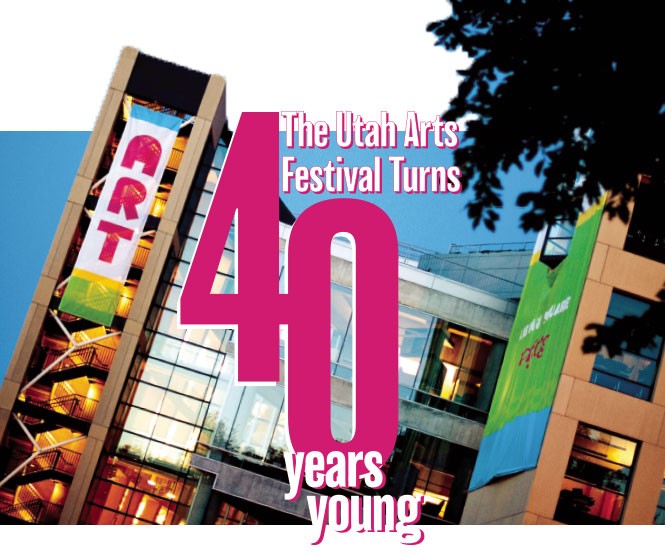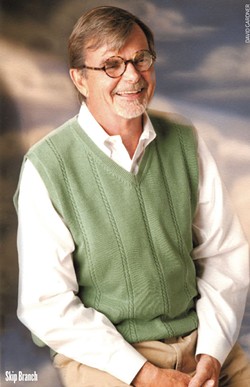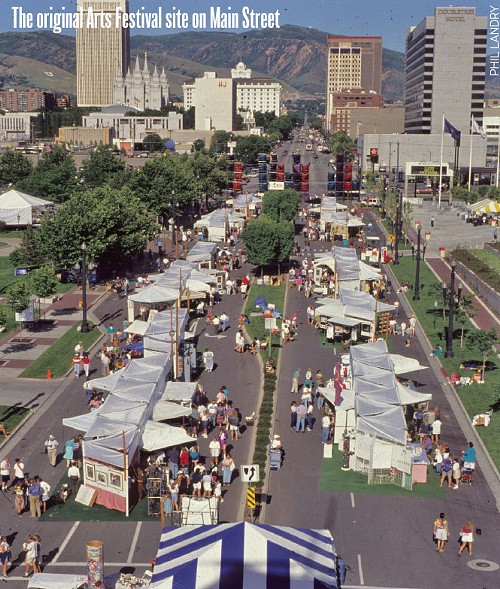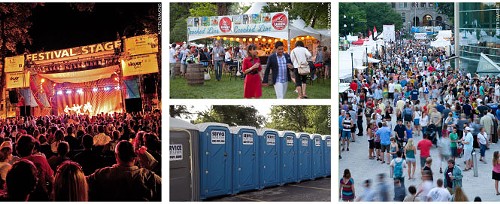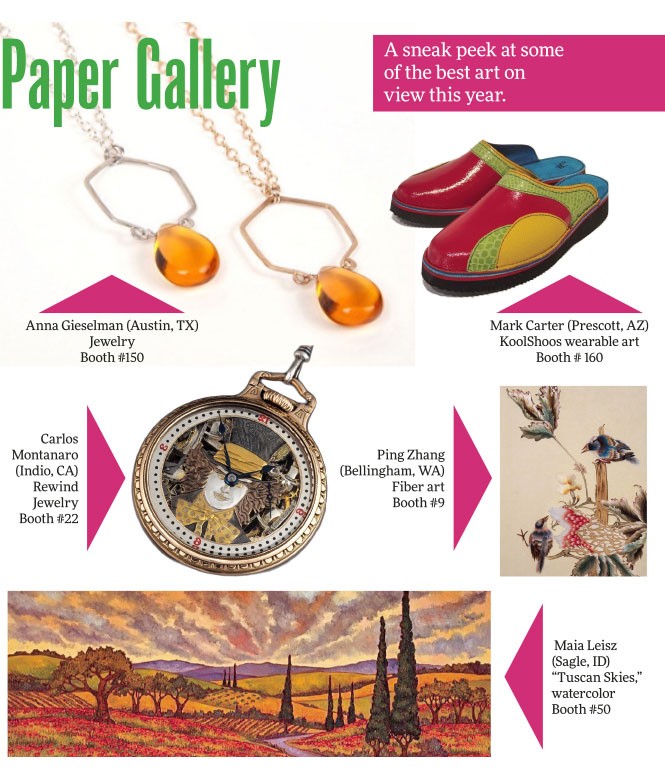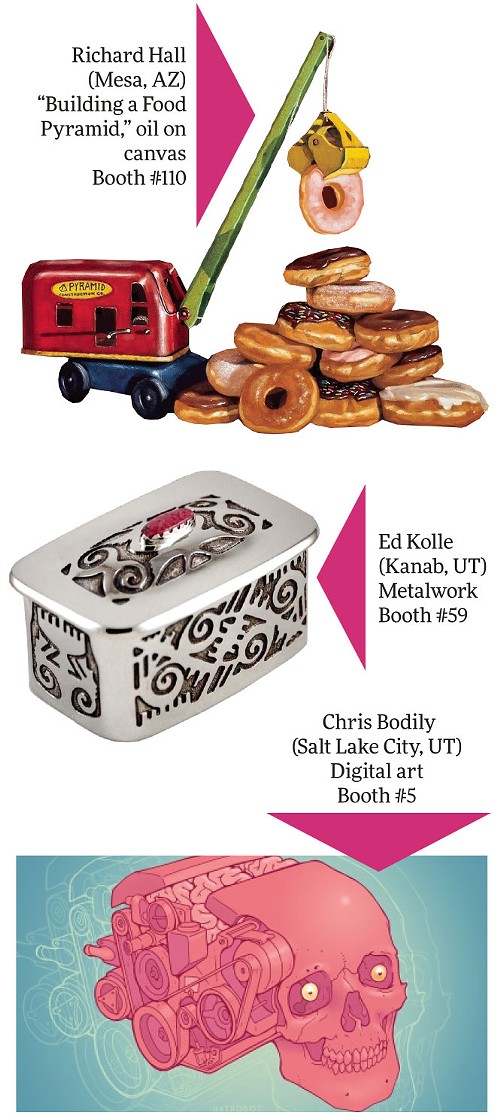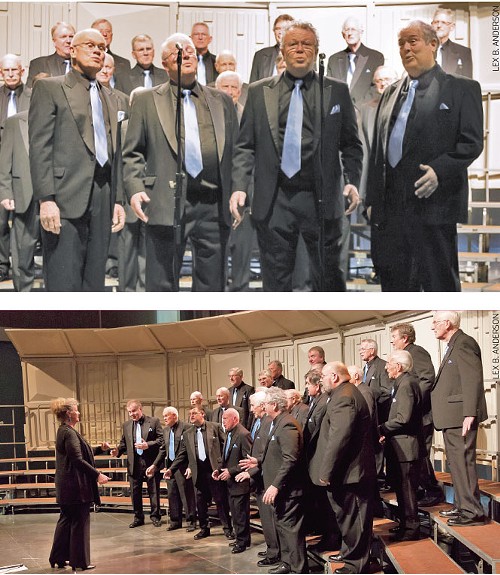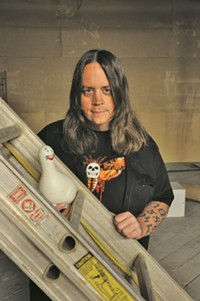The Utah Arts Fest turns 40 Years Young
The past, present and future of the ever-morphing arts fest.
By Scott Renshaw @scottrenshaw and Randy HarwardEvery summer, thousands of Utah residents pack the downtown area for the Utah Arts Festival. They stroll through artist booths, listen to live music, explore hands-on art areas, watch short films—in short, get a sampler platter of the astonishing wealth of artistic talent this state has to offer.
But how did that festival get here?
For this 40th anniversary milestone of the Utah Arts Festival, we look back at how it all began, with colorful reflections by the festival's first director on its improbable birth. We also check in with the current festival staff member whose job it is to build the festival grounds every year, and learn a little bit about the challenges of bringing one group of performers to Utah this year. Then we'll give you a chance to browse through images by some of this year's participating artists, introduce you to a group that will be performing barbershop vocals for UAF guests, and help you make plans to attend with our handy logistics guide.
The Utah Arts Festival may be hitting the big four-oh, but it's hardly over the hill. Get ready to find out about the journey that has taken it to yet another peak.
Birth of a Festival
By Scott Renshaw
Potty Over here
By Scott Renshaw
Paper Gallery
By Scott Renshaw
Pitch Prefects
By Randy Harward
2016 Utah Arts Festival Guide and Highlights
By Scott Renshaw
Birth of a Festival
Utah Arts Festival's first director Skip Branch recalls the strange journey towards its creation
By Scott Renshaw
Forty years ago, before there was a Utah Arts Festival, there was a Salt Lake City Festival of the Arts. And before there was a Salt Lake City Festival of the Arts, there was a group of people sitting around in a room, drinking wine, dreaming up the crazy idea of putting art in the middle of downtown Salt Lake City streets.
Seated at a table in Oasis Café on a June afternoon, Skip Branch tells the story of that first gathering—and the events that followed—with an infectious enthusiasm and well-deserved pride. "We worked so hard with so little, and that's a real pleasure," Branch says. "It was one of the great things that happened in my life."
Ironically, it happened in large part because of information about how people didn't want to experience art. In the mid-1970s, Branch—whose primary work was in communications and public relations—was a member of the Salt Lake Arts Council. And it wasn't exactly a glamorous position, as Branch recalls it: "You meet once a month, talk about how much money you have, and the budget this year is, oh, $180. Well, that's great."
It was at one of these meetings that another member of the Arts Council, University of Utah Museum of Fine Arts director Frank Sanguinetti, told the other members about then-recent research regarding people's attitudes about the arts. "People felt intimidated by going to an art gallery," Branch says of the study's findings. "And I think we all have that feeling: You need to know the history of the artist, know about art itself besides 'I like it/I hate it.'" For many of the respondents, a gallery setting "almost felt claustrophobic, more emotionally than physically."
"'God, Frank, that's amazing,'" Branch says of his reaction at the time. "And I don't know which one of us, said, 'You know what we ought to do? Throw it in the street. If people don't like the building, have a big art exhibit out in the street.' And we all laughed, thought it was fun—and had another glass of wine."
Over the course of that evening, the idea started to evolve. It expanded from only visual arts to also including performing arts. There would be a need to feed the attendees, which could be its own "food arts" component; there would need to be activities for kids. "And you can imagine," Branch says, "in this enthusiastic group, drinking wine, 'This is so cool, I think we've got something here. Now what do we do?' You've got this nugget of an idea, and like a lot of good ideas, who's gonna carry this one? So they turned to me, because [then-mayor] Ted Wilson was a friend of mine, they said, 'Skip, talk to Ted.' And I said, 'Oh God ... sure.'"
Wilson, as it turns out, was enthusiastically in favor of the idea—but not quite so enthusiastic about the proposed location in the middle of Main Street, which would require shutting it off to traffic. "Ted said, 'Uh, really? Don't you want to do Liberty Park?' We said, 'It's not like you don't close Main Street once a year for the Days of '47 Parade. And we've got no horseshit. The clean-up is much easier.'"
Branch and the Arts Council were ultimately able to convince Wilson that Main Street was the right location. But once the word got out to Main Street merchants, they wanted to squash the idea. "Ted calls me, says, 'We're done. Can't do it.' ... I didn't know who I knew, the only guy I thought could be accessible was Jack Gallivan, the publisher of the Tribune. So I called Gallivan's office, set up an appointment, and I told Mr. Gallivan the story. He said, 'This has to happen.' I almost burst into tears.
"The next call I get is from Ted, and he says, 'What the hell did you do? The festival is on. We're doing it.'"
Not surprisingly, that was far from the only complication for a start-up venture of this kind. First, the fire department tried to shut down the idea, since the initial plan didn't meet code requirements, requiring a more formalized street plan. And of course there was the matter of that $180-ish budget, which required plenty of creative use of resources that the organizers could get for free.
"[Arts Council member] Lake Churchill was a colonel at Fort Douglas," Branch recalls of one such situation. "Lake says, 'Well, you've got to put it up and take it down, don't you? Let's get the army.' 'The army? You mean, like, the Army army?' The next thing you know, we've got the green trucks you see in the movies and shit, with guys in 'em, bringing stuff down, helping with the construction.
"It really was a case of, we can get chairs from the city, which used them at the Utah State Fairgrounds. We can get some of the temporary outdoor staging that the Symphony and the Shakespearean Festival used. Lighting? Well, it turns out Susan Burrell of Ballet West, her husband, Kay, does all of the lighting for the Ballet, other dance groups. He's gonna light the whole goddamn thing. ... They were making some kind of drink in a sterilized garbage can. It was that funky. And it was marvelous."
It was a massive undertaking for a smaller city, but Branch also believes the close-knit nature of the Salt Lake arts community made it possible to put on an event of this kind, with so many people willing to give of their time for no compensation. The richness of that arts community also made it possible for the event to be attractive, presenting the kind of world-class talent that was available.
"Forty-two years ago, the Utah Symphony was recording for ABC Records," Branch says. "Ballet West was traveling the world. RDT was given a Rockefeller Grant to start their organization. So you weren't dealing with people who were, like ... doing cute little ceramic figures with a bunny face and a couple of eyes and we'd sell that. We're talking well-studied, well-prepared, gifted artists. So grabbing the vision, making it a classy one? That was all available."
The first two years of the Salt Lake City Arts Festival were a tremendous success, but the organizers became even more ambitious. Branch recalls that it was Bruce Spears of Repertory Dance Theater who suggested going to the Utah Legislature and asking for funding. "So Bruce and I went up to talk to them," he says, "and we're 'the arts,' so that makes us Communists, early dope-smokers, just be careful what we say here. We have to talk about the vision of it in a slightly different way.
"Meanwhile, a pal of mine says to me, 'I don't think there's a state arts festival in the nation.' And you couldn't Google it then; you'd have to write to all 50 states. So I thought, 'I'm going with that. Even if I'm wrong, they've got to prove it. Let them write the letters.'"
The presentation earned $70,000 in funding from the Legislature, and the Utah Arts Festival was born, relocating from Main Street to West Temple, in front of the Salt Palace. Branch became the first chair of the UAF, serving only for a year before moving on. "I didn't want to become Grandfather Festival," he says. "I was the original chair, and that was that. After three years, it was taking too much of my life, and I needed to wean myself from it. The best time to leave is before you wish you had."
Yet Branch still attends every year. He's amazed at what it has grown to become, and credits current director Lisa Sewell with overseeing such a massive annual undertaking. He particularly notes the people-watching element of the festival, and what it says about the way the state has evolved over those 40 years. "You see people there who are nice little conservative Mormon families, and people with their body painted, walking together, and that's astounding," Branch says. "One of the things I've always liked about it, from the start to the present: It really does show the diversity of our state. And welcomes it, and promotes it."
"We had no idea that it would last this long. If anyone had asked us then, I'd have said, 'Oh, absolutely.' But did I really envision that? Not more than a fantasy."
Forty years later, the result of that fantasy still lives in Salt Lake City.
Potty Over Here
The unglamorous but crucial job of building the Utah Arts Festival.
By Scott Renshaw
Patrick Burns doesn't really understand why I want to interview him. "My job is not the glamorous one," says the Utah Art Festival's assistant director and technical director. "I figure out where the port-a-potties should go."
That's an accurate statement, as far as it goes—which isn't nearly far enough. Burns' humble understatement notwithstanding, he gets to oversee all of the behind-the-scenes logistical work that allows an estimated 85,000 to 90,000 attendees to enjoy the Utah Arts Festival annually without really noticing all that work. Because if people are noticing, it's probably because something went wrong.
Burns has been in his current position for seven years, but has spent 18 years total with the Arts Festival and 16 years as a full-time employee, working his way up from an internship and also doing publicity work along the way. "People always ask, 'You work for the Arts Festival ... year-round?'" Burns says. "'What do you do the rest of the year?'"
The long answer to that simple question is "a lot," beginning literally from the moment the current year's festival ends. The tear-down of the fencing, stages, booths and other infrastructure takes two days, with the goal of having the surrounding streets—particularly 200 South between the City & County Building and the Library—open by 5 p.m. on the Tuesday after the festival, "We have not missed that deadline since I've been in this position," Burns adds with some understandable pride. "Then we take three or four days off, come back to the office, clean everything up, and start doing the numbers. Part of my duties is to do the annual report: how many people came through the gates, the temperature, profit margin on sales."
That's only the beginning of the administrative side of the post-festival work, which includes presenting the report to the UAF board in August, developing the budget for the next year, then beginning the permitting process with various government entities—the city, the health department, DABC—once the new fiscal year begins Oct. 1. "You have to meet with a lot of different departments," Burns says. "Our last meeting is today," he adds on the day we spoke—a day less than three weeks before the festival was set to open. "When you try to plan a party that you have to build a small city for, with all the accompanying infrastructure ..."
Then there's the question of where to place every stage, booth, table and, yes, port-a-potty—a job which in some ways gets easier with the passage of time and certain things continuing as they have been, but which also involves constantly reviewing what could be better logistically, whether for the experience of guests or for the experience of artists, performers and vendors. And while no change is ever going to meet with 100 percent approval, a lot of thought goes into it.
"People asked why we moved the Festival Stage into the sun last year, when it used to be on the grass for years and years and years, in the shade," Burns says. "Well, this stage has maybe five or six performances on it, depending on the day, and the rest of the time it was just sitting in the shade. Meanwhile, 70-plus artists are sitting out in the sun, with patrons trying to shop in the sun. So we moved the artists into the shade, and mostly program the stage at night, after it cools off. We also needed a larger stage for acts like the Utah Symphony, and there just wasn't room on the grass to build a larger stage."
And not every change which seems initially like a great idea works out as planned. Last year, Burns attempted a different organization of many of the artist booths in "pods of four," rather than longer rows, which created more of the envied "corner" positions that always seem to get more visitor traffic. "What I didn't realize," says Burns, "is that patrons, as they're walking around, get confused. They couldn't remember if they'd been to Booth 56 yet, or 47. So this year we're putting them [back] in rows, so people know if they've walked in a straight line."
Examples like that are the ones that visitors and artists might actually notice; other work goes on so invisibly that nobody will notice: the placement of cords that supply electrical power, or where to have artists and vendors load in and load out their supplies. Burns is always considering the impact of the festival's operations on what he refers to repeatedly as "our neighbors," from actual festival venues like The Leonardo to surrounding businesses on the bordering streets. After several years in his current role, and with the festival in the same physical location, certain elements have become simpler in terms of budgeting and in the production schedule—Burns offers the example of, "oh yeah, the plumber's got to come today"—yet there are always new variables, from the weather to construction, like the work on the City & County Building scheduled to begin later this year.
And even simple matters like planning the festival layout based on a to-scale map always seem to throw a few curve balls. "You measure it out, and on the map it shows that there should be 25 feet," Burns says. "Then you go down [to the site] and measure with the wheel, and you try to put up a tent that's 25 feet, and for whatever reason, ... something just doesn't fit. That's kind of a personal goal: Everything just went like the map showed. But it rarely happens."
Everything still does somehow manage to fit, even as the festival's attendance continues to grow. Burns believes that, given some creativity with using the existing venue and getting people to attend earlier, it should be able to hold 100,000 or more. Any additional growth of the physical site, were it necessary, might come from expanding further east, toward the Public Safety Building. "The only concern with that is we use 300 East for our staging area, our tech crew boneyard, our rental crew. We need a place for the ugly stuff to sit. And we try to keep it out of the patron view. What we're searching for is a peak experience, so when people come to UAF, they feel like they're walking into a beautiful park with really high-quality art. ... So we need a place for the ugly stuff to sit so they don't walk into that."
Which brings us back to the location of those port-a-potties, and the decision to remove one of the "pods" of toilets from a location nearer to a festival stage. While the same total number of facilities will still be on the festival grounds, Burns realized that the sound of the doors slamming was interfering with the experience of watching performances. Additionally, Burns says, "To the side of the stage, that road slopes, so they were ... not as steady as we'd like."
It's not glamorous work. But even if you'd rather not think about things like an unsteady port-a-potty, you should be glad that Patrick Burns does.
Pitch Prefects
After nearly 70 years, the Beehive Statesmen Barbershop Chorus continues to seek harmony.
by Randy Harward
This is an old group," says Doug Jones, president of the Beehive Statesmen Barbershop Chorus. Sitting in a South Salt Lake coffee shop, he and fellow member/marketing and public relations officer John Close look to Sharon Gardner, the Statesmen's former president and oldest living member (and Jones' great-uncle), to determine exactly how long the Statesmen have been harmonizing.
Gardner, 79, recalls that he first sang with the Statesmen in 1959, 10 years after they chartered, but that they'd been performing since 1948. (Jones has nearly 21 years with the group. Close is approaching his second anniversary.) That's almost 70 years. "We had over 125 membership [at one time], and we put, consistently, for quite a number of years, 80-plus [members] on stage." He says that "hundreds" of Statesmen have come and gone over the years, "and more than a hundred have passed away."
"Nowadays, we're a lot smaller," Jones says. "We only put 25 or so on stage."
Within the chorus are smaller quartets (4th Street, SLiCk City, Gray Matters) that perform separately. A barbershop chorus is the same as a barbershop quartet, says Jones—"just more [of it]." A quartet sings four-part harmonies, with one person singing lead (the main melody), tenor (high line), bass (low end), and a baritone singing "whatever's left over—we call it the garbage part," jokes Jones, a lead.
"Don't say that in the article," says Close, who along with Gardner, sings bass. The three men erupt into laughter.
"Good baritones are hard to find, so you try not to insult them," Close says.
"But I do it consistently," Jones protests.
"Well, you're a jerk," Close teases.
I tell them this sounds like the barbershop version of rock-band drummer jokes. "How do you know if the stage is level?" Close blurts out. "The drummer is drooling out of both sides of his mouth!" The trio cracks up.
In all seriousness, Jones says, "Baritone is probably the hardest part to sing." Gardner seconds this: "No question." It's a utility role; a baritone must sing whatever notes—high or low—are needed to complete the chords that comprise that classic barbershop sound, which is a more technical form of a cappella. Jones quotes a cappella pioneer Deke Sharon: "A cappella is the martial arts of singing; barbershop singers are the black belts."
To underscore Sharon's point, Gardner tells the story of the first year that Salt Lake City hosted the International Championships, and the then-champs from Dallas sang with the renowned Mormon Tabernacle Choir. "[MoTab] started to sing so that you could understand the words, after that. They're a pretty top-flight organization but, yeah, they went to school."
The technicality is important, because the harmonies are why barbershop music gives chills to singers and listeners alike. "The sound is amazing when it's done right," Jones says. "You can tell when you're doin' it right, because it gives people goosebumps." Gardner recalls the words of a former Statesman, who liked to say that locking in the harmonies "makes your skin feel like a sack of BBs."
We all hold up our arms to show gooseflesh and raised hairs prompted by simply talking about the music. What is it about barbershop, that mere discussion of it causes a physical reaction? Surely there is a scientific explanation, but none of us at the table know it. But they say people give off vibes, that we resonate with each other. Musical notes are vibrations. Locking in a harmony with someone, actively trying to resonate together, must achieve a deeply human connection.
Gardner, Jones and Close say locking in the harmonies doesn't happen all the time. Some nights, it doesn't happen at all. But getting together in a room with a bunch of people who are content just trying to harmonize, and who share a tendency to lift their voices to test the acoustics of random foyers, hallways, stairwells and elevators, is magical. Ultimately, Jones says, "We just sing to sing."
The Beehive Statesmen Barbershop Chorus
Utah Arts Festival (Festival Stage) @ Library Square
200 E. 400 South
Thursday, June 23, 7 p.m.
801-322-2428
Free (pick up admission vouchers at the gate)
UAF.org
2016 Utah Arts Festival Guide and Highlights
By Scott Renshaw
The 2016 Utah Arts Festival takes place June 23-26 in downtown Salt Lake City on 400 South between State Street and 300 East, noon-11 p.m. daily. Here's everything you need to know if you're planning to attend.
Tickets: For the first time this year, the opening Thursday will be free admission all day. Adult tickets (ages 13-64) are $12 per day Friday-Sunday; seniors (65+) $6; free ages 12 and under. The "Weekday Lunchtime Special" continues this year, with $6 adult tickets available if purchased Friday before 3 p.m. A 4-day all-festival pass (available at the festival box office Thursday only) is $30; those who attend and purchase tickets on Friday or Saturday can receive a two-for-the-price-of-one ticket for a return visit. Festival box offices accept cash only; ATMs are positioned outside the festival grounds for those who need to use them. Purchase tickets and/or enter at any one of five entrances on the perimeter of the festival grounds; no need just to get backed up at the main entrance on 400 South, where folks will be pouring off the trains.
Parking/Transportation: Downtown SLC offers plenty of parking spaces, but not a lot of them are convenient to the festival grounds, especially if you're pushing a stroller or walking with kids. If at all possible, make use of Trax, taking (or transferring to) the Red Line and getting off at Library Square stop. Trains usually run every 15-20 minutes, and UTA will be running extended service every day of the festival, with the last train leaving Library Square at 11:30 p.m. to accommodate those staying for the late music headliners. Free valet bicycle parking is also available for those who chose to bike to the festival—and those who do so will also get a $2 discount on festival general admission. The same discount applies to those who take Uber and register online at Get.Uber.com/go/ARTLIVESHERE.
What to Bring/What Not to Bring: Outside food and beverage (except for factory-sealed water bottles) are not permitted inside the festival grounds. Free ice water is available, however, and bringing a wide-mouth empty reusable water bottle is a good way to avoid having to make multiple visits on a warm day. Also prohibited: weapons, skates/skateboards, pets (except service animals) or anything intended for solicitation (posters, flyers, etc.) Do bring: sunscreen/hats/other sun protection, cash (or your ATM card, if you don't care about the surcharges for using a machine that's not from your own bank), weather-appropriate attire (including something for if you plan to be around after the sun goes down), comfortable walking shoes, ID (if you plan to purchase alcohol).
Food Vendors: More than a dozen local restaurants and specialty food providers will be represented in the festival food court and at other select locations. Again: Bring cash. Plenty of kid-friendly options will be available—including The Pie pizza and the PB&J booth in the kids' Art Yard—as well as offerings from Yoshi's Japanese Grill, Dionysos Greek, Crepe Time and more. Seating in the shaded table area is generally hard to come by during peak lunch and dinner hours, so consider eating earlier or later to avoid lines and find a place to sit. Or be bold and friendly, and ask to pull up a chair at an already-occupied (but large) table.
Other Important Facilities: A first aid station (also one of the locations for free water) is located near the northeast corner of The Leonardo. Security and Lost & Found can be found in the retail space near the main Library Arch entrance (mid-block on 400 South, between 200 East and 300 East). Most of the toilet facilities will be port-a-potties—located in two main groupings near the Park Stage and Art Yard—but those who are particularly fastidious or need to change a baby might want to use the restrooms on the lower level of the library building, with access opposite the library auditorium used for the Fear No Film Festival.
Schedule of Performances/Music Headliners: Dozens of music groups, dance groups, comedians, spoken word artists and others will be at the festival's various venues throughout the four days. For a full schedule of events—whether by date or by category—visit the festival website at UAF.org/Schedule, or download the official UAF app.
More by Scott Renshaw
-
CHALLENGERS feature movie review
Zendaya centers a romantic triangle with a unique relationship spin
- Apr 24, 2024
-
Film Reviews: New Releases for April 19
The Ministry of Ungentlemanly Warfare, Abigail, The Beast, Hard Miles, Sasquatch Sunset and more
- Apr 19, 2024
-
Faces of Salt Lake County book and portrait reception
Images and personal stories in a new book reveal local demographic diversity
- Apr 17, 2024
- More »
More by Randy Harward
-
Live Music Picks: April 19-25
MC Chris, Talia Keys & the Love, Nick Passey, Brian Wilson and more.
- Apr 18, 2018
-
Live Music Picks: April 12-18
Judas Priest, The Residents, Clownvis Presley, The Breeders and more.
- Apr 11, 2018
-
Rock-It Fuel
Local musicians dish on the grub that puts the bomp in their bomp-bah-bomp-bah-bomp.
- Apr 11, 2018
- More »
Latest in Cover Story
Readers also liked…
-
Forget the family pedigree—Robert F. Kennedy Jr should not be the next president of the United States
Trojan Horse
- Jun 21, 2023
-
Women decry harassment and toxic culture at St. George auto dealership
Men at Work
- Oct 11, 2023


